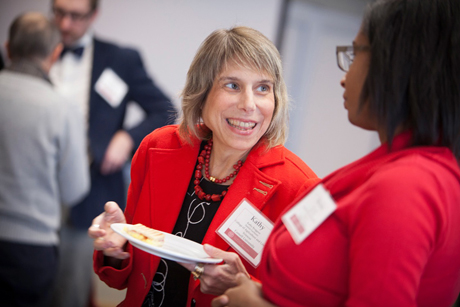Student input drives business communication course
By Stacey Shackford

When senior lecturer Kathy Berggren ’90, MAT ’93, was designing her new course in management communication, she borrowed a page from her new department and turned to her end users for advice: students.
A team of seven undergraduates helped develop the curriculum for the introductory course in the Dyson School of Applied Economics and Management, AEM 2700, offered for the first time this semester.
Many, like Hillary Pond ’13, were Dyson students who took Berggren’s previous communications course, COMM 2010; several will also have a hand in delivering the curriculum to 90 freshmen as teaching assistants in three back-to-back lecture sessions with 30 students each.
“The aim of this course is spot on,” Pond said. “I wish I had been able to take it when I was a freshman.”
The top priority the students identified: developing core skills to help land internships and jobs, including compiling resumes, writing cover letters and acing interviews.
Learning such skills early on will be a boon to business students, said Pond, who advises her peers as president of the business fraternity Alpha Kappa Psi.
“The course will be key as students start applying for internships and jobs, especially for those Dyson students, like myself, who had little formal work experience as a freshman,” Pond said.
The course will also include lessons in business briefs, elevator pitches, oral presentations, audience analysis, crisis communication and group collaboration – another skill Pond wishes she had acquired as a freshman.
“It provides a great opportunity to do what you might not otherwise do until upper-level courses, where there are a lot of presentations and group work,” Pond said. “It is also a unique classroom setting for an introductory course, where very few lectures are less than 100 students. For a freshman, that can be daunting. In this class, they will get to know each other well.”
They will also get to know themselves a little better, thanks to self-reflection exercises Berggren built into the curriculum.
“Self-reflective people learn from their successes and failures,” Berggren said. “I want to challenge them to think differently.”
Pond said she appreciated the opportunity to help shape a course and make it as interactive and engaging as possible for her fellow students. She said Berggren did a good job of building on the most successful elements of COMM 2010 while also incorporating business-student input and tailoring it to their needs.
“Out of all the professors I have had, I think she is one of the most receptive to student feedback,” Pond said.
Berggren, a recipient of several teaching and advising awards who has taught in the Department of Communication for 20 years, said she will continue to consider the user experience. She will be setting up a student advisory council to evaluate the course and offer recommendations at the end of each semester.
“I do not want to spend another 15 years teaching the same way. This way, the course stays current and connected to the industry. Students have ownership, buy-in and input,” Berggren said.
“Every endeavor that I do, I try to collaborate with students,” she added. “I’m a facilitator, and that’s what I love about teaching. I’m happy to be in the background and let my students shine.”
Stacey Shackford is staff writer for the College of Agriculture and Life Sciences.
Media Contact
Get Cornell news delivered right to your inbox.
Subscribe